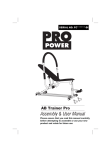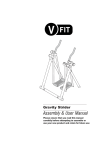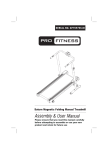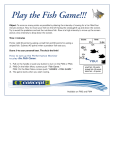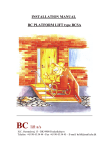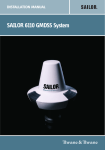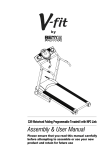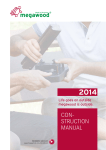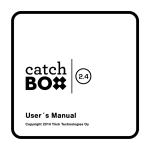Download Assembly & User Manual
Transcript
SERIAL NO. TS******-DI DUAL SCULLING HYDRAULIC ROWER Assembly & User Manual Please ensure that you read this manual carefully before attempting to assemble or use your new product and retain for future use Contents Section Page General Information . . . . . . 4 Before you start . . . . . . . . . 5 Safety . . . . . . . . . . . . . . . . . 6 Exercise Information . . . . . . 7 Assembly . . . . . . . . . . . . . . 16 General lnformation Quality Guarantee This exercise product has been designed and manufactured to comply with the latest (BS EN 957) British and European Safety Standards. This product is guaranteed for DOMESTIC USE ONLY for a period of 1 YEAR from the original certified date of purchase. During this period we have the right to: - Questions Should you encounter any difficulty with the assembly, operation or use of your exercise product or if you think that you may have parts missing, please DO NOT return it to your retailer but contact CUSTOMER SUPPORT, by either of the following means. Customer Support Email:- [email protected] Fax:- 01535 637722 Post: D.I. Support c/o Unit 8, Riparian Way, The Crossings, Cross Hills, West Yorkshire BD20 7BW Queries If you do have any queries, please ensure that you include the following information YOUR NAME YOUR ADDRESS YOUR PHONE NUMBER PRODUCT MAKE OR BRAND PRODUCT MODEL PRODUCT SERIAL NUMBER DATE OF PURCHASE NAME OF RETAILER PART NUMBERS REQUIRED Page 4 a). Provide parts for the purchaser to effect repair. b). Repair the product, returned to our warehouse (at the purchaser's cost). This guarantee does not cover wear and tear on upholstery or consumables. This guarantee does not cover abuse, defects caused by storage or use outside those intended. If you need to advise us of a defect with your product and in order for us to service any requirement for replacement parts or repairs, we may ask for proof of purchase. Failure to do so may result in any claim for replacement parts or repairs being refused. This guarantee, (both given and implied) applies to the original purchaser only, is not transferable and will be invalidated if used outside of the above criteria. This guarantee is valid only in the United Kingdom and Eire. This does not affect your statutory rights as a consumer. Before you Start Tools If required, most of our products are supplied with basic tools, which will enable you to successfully assemble your product. However, you may find it beneficial to have a soft-headed hammer and perhaps an adjustable spanner handy as this may help. Prepare the Work Area It is important that you assemble your product in a clean, clear, uncluttered area. This will enable you to move around the product while you are fitting components and will reduce the possibility of injury during assembly. Work with a Friend You may find it quicker, safer and easier to assemble this product with the help of a friend as some of the components may be large, heavy or awkward to handle alone. Open the Carton. Carefully open the carton that contains your product, taking note of the warnings printed on the carton to ensure that the risk of injury is reduced. Be aware of sharp staples that may be used to fasten the flaps as these may cause injury. Be sure to open the carton the right way up, as this will be the easiest and safest way to remove all the components. Unpack the Components Carefully unpack each component, checking against the parts list that you have all the necessary parts to complete the assembly of your product. Please note that some of the parts may be pre-fitted to major components, so please check carefully before contacting our CUSTOMER SUPPORT team. In any event, please do not return the product to your retailer before contacting us first. Page 5 Safety Before you undertake any programme of exercise that will increase cardiovascular activity please be sure to consult with your doctor. Frequent strenuous exercise should be approved by your doctor and proper use of your product is essential. Please read this manual carefully before commencing assembly of your product or starting to exercise. * Please keep all children away from exercise products when in use. Do not allow children to climb or play on them when they are not in use. * For your own safety, always ensure that there is at least 1 Metre of free space in all directions around your product while you are exercising. * Regularly check to see that all nuts, bolts and fittings are securely tightened. Periodically checking all moving parts for obvious signs of wear or damage. * Clean only with a damp cloth, do not use solvent cleaners. If you are in any doubt, do not use your product, but contact CUSTOMER SUPPORT by any of the means listed on the opposite page. * Before use, always ensure that your product is positioned on a solid, flat surface. If necessary underneath to reduce the possibility of slipping in use. * Always wear appropriate clothing and footwear such as training shoes when exercising. Do not wear loose clothing that could become caught or trapped during exercise. Storage and Use Your product is intended for use in clean dry conditions. You should avoid storage in excessively cold or damp places as this may lead to corrosion and other related problems that are outside our control. Weight Limit Your product is suitable for users weighing: 242LBS / 17.2 Stones / 110KG or less. Conformity This product conforms to: (BS EN 957) - PARTS 1 and 7 Class (H) - HOME USE - Class (C). It is NOT suitable for therapeutic purposes. Page 6 Exercising Information Beginning How you begin to exercise will vary from person to person. If you have not exercised for a long period of time, have been inactive for a while, or are severely overweight you MUST start slowly, increasing your exercise time gradually, by perhaps only a few minutes for each session per week. Combine a carefully structured nutritious diet with a simple but effective exercise routine and this can help make you feel better, look better and will almost certainly enable you to enjoy life more. Aerobic Fitness Aerobic exercise is simply defined as any sustained activity that increases the supply of oxygen to your muscles via the blood pumped by your heart. With regular exercise, your cardiovascular system will become stronger and more efficient. Your recovery rate i.e. the time taken for your heart to reach its normal resting level, will also decrease. Initially you may only be able to exercise for a few minutes each day. Do not hesitate to breathe through your mouth should you need more oxygen. Use the "talk test". If you cannot carry on a conversation while exercising, you are working too hard! However, aerobic fitness will be gradually built up with regular exercise, over the next six to eight weeks. Do not be discouraged if it takes longer than this to begin to feel less lethargic, everyone is different and some will achieve their targets quicker than others. Work at your own, comfortable pace and the results will come. The better your aerobic fitness the harder you will have to work to stay in your target zone. Page 7 Exercising Information Warm Up A successful exercise programme consists of three parts, Warm Up, Aerobic Exercise and Cool Down. Never start a training session without warming up. Never finish one without cooling down correctly. Perform between five and ten minutes of stretching before starting your workout to prevent muscle strains, pulls and cramps. Aerobic Exercise Session Those new to exercise should exercise no more than every other day to start with. As your fitness level increases, increase this to 2 in every 3 days. When you are comfortable with your routine, exercise for 6 days per week. Always take at least one day off per week. Exercising in your Target Zone To ensure that your heart is working in its exercise target zone, you need to be able to take your pulse. If you do not have a pulse monitor (either from the product you are using or a proprietary independent unit) you will need to locate the pulse in your carotid artery. This is situated in the side of the neck and can be felt by using the index and middle fingers. Simply count the number of beats you feel in 10 seconds and then multiply by six to get your pulse rate. This should be taken before you start to exercise for easy reference. People who have a greater aerobic fitness, have a lower resting pulse level and will also be able to exercise with a higher pulse level. Target Zone To determine your target zone, see the chart opposite. If you are new to exercise and by definition unfit, refer to the left column. If you exercise regularly and have good aerobic fitness, refer to the right column. Page 8 Exercising Information Target Zone (con't) USERS AGE (Years) 20-24 25-29 30-34 35-39 40-44 45-49 50-54 55-59 60 and over UNCONDITIONED TARGET ZONE - A (Beats per Minute) 145 - 165 140 - 160 135 - 155 130 - 150 125 - 145 120 - 140 115 - 135 110 - 130 105 - 125 CONDITIONED TARGET ZONE - B (Beats per Minute) 155 - 175 150 - 170 145 - 165 140 - 160 135 - 155 130 - 150 125 - 145 120 - 140 115 - 135 Cool Down To decrease fatigue and muscle soreness, you should also cool down by walking at a slow relaxed pace for a minute or so, to allow your heart rate to return to normal. Warm Up and Cool Down Exercises Hold each stretch for a minimum of ten seconds and then relax. Repeat each stretch two or three times. Do this before your Aerobic Exercise session and also after you have finished. Head Roll Rotate your head to the right for one count, feeling a slight pull on the left side of your neck. Next, rotate your head back for one count, stretching your chin. Then rotate your head to the left for one count, feeling a slight pull on the right side of your neck. Lastly, drop your head to your chest for one count. Repeat 2 to 3 times. Toe Touch Slowly bend forward from your waist, letting your back and shoulders relax as you lower your trunk. Gently stretch down as far as is comfortable and hold for 10 seconds. Page 9 Exercising Information Shoulder Lift Rotate and lift your right shoulder up towards your ear for one count. Relax then repeat for the left shoulder. Repeat 3 - 4 times. Calf / Achilles Stretch Turn towards the wall and place both hands on it. Support yourself with one leg while the other is placed behind you with the sole flat on the floor. Bend the front leg and lean towards the wall, keeping the rear leg straight so that the calf and Achilles tendon are stretched hold for 5 seconds. Repeat with the other leg. Repeat 2 - 3 times. Side Stretch Open both arms to the side and gently lift them above your head. Reach your right arm as high as you can for one count, gently stretching the muscles of the stomach and lower back. Repeat the action with your left arm. Repeat 3 - 4 times. Inner Thigh Stretch Sit on the floor and pull your legs toward your groin, the soles of your feet together. Hold your back straight and lean forward over your feet. Tighten the thigh muscles and hold for 5 seconds. Release and repeat 3 - 4 times. Hamstring Stretch Sit on the floor with your right leg extended and place your left foot flat against the right inner thigh. Stretch forward toward the right foot and hold for 10 seconds. Relax and then repeat with the left leg extended. Repeat 2 - 3 times. Page 10 Exercising Information Basic Aerobic Training Programme For your basic Aerobic Exercise routine we suggest that you try the following. Remember, breathe correctly, exercise at your own pace and do not over-train as injury may result. Week 1 & 2 Warm Up 5 - 10 Minutes Cool Down 5 Minutes Week 3 & 4 Warm Up 5 - 10 Minutes Cool Down 5 Minutes Week 5 & 6 Warm Up 5 - 10 Minutes Cool Down 5 Minutes Week 7 & 8 Warm Up 5 - 10 Minutes Cool Down 5 Minutes Week 9 & beyond Warm Up 5 - 10 Minutes Cool Down 5 Minutes Exercise 4 minutes at 'A' Rest 1 minute Exercise 2 minutes at 'A' Exercise slowly 1 minute Exercise 5 minutes at 'A' Rest 1 minute Exercise 3 minutes at 'A' Exercise slowly 2 minutes Exercise 6 minutes at 'A' Rest 1 minute Exercise 4 minutes at 'A' Exercise slowly 3 minutes Exercise 5 minutes at 'A' Exercise 3 minutes at 'B' Exercise 2 minutes at 'A' Exercise slowly 1 minute Exercise 4 minutes at 'A' Exercise slowly 3 minutes Exercise 5 minutes at 'A' Exercise 3 minutes at 'B' Exercise 2 minutes at 'A' Exercise slowly 1 minute Repeat entire cycle 2 or 3 times This is only a suggested programme and may not suit every individual's needs. Page 11 Exercising Information EXERCISING WITH YOUR SCULLING HYDRAULIC ROWING MACHINE It is possible to use your Sculling Hydraulic Rowing Machine in two different ways, to increase cardiovascular fitness and create lower body / upper body leg and arm strength. AEROBIC WORKOUT It is possible to manually increase or decrease the rowing resistance for aerobic workouts on your Sculling Hydraulic Rowing Machine in order to build cardiovascular fitness. The resistance levels should be set to the lower part of the rowing-arms before you start to exercise. However, the rowing-arm strength also increases proportionately with the rowing speed and effort. E.g. the harder or quicker you row, the more resistance is created by the 2 hydraulic cylinders. With all aerobic exercise, you should exercise at a constant, reasonable pace when warmed up. (See the section about Warm-Up and Target Heart Rate Training elsewhere in this booklet). The aerobic benefit of the exercise will increase as the rowing rate increases and your cardio-vascular fitness will benefit as a result. The muscles in the legs, thighs, arms and lower back will also be strengthened by the rowing action. STRENGTH WORKOUT Note As with the Aerobic Workout, it is possible to directly increase the rowing resistance for a full strength workout on your Sculling Hydraulic Rowing Machine in order to build muscle strength. The resistance levels should be set to the upper part of the rowing-arms before you start to exercise. However, if you increase your rowing-arm strength in order to generate more resistance on the 2 hydraulic cylinders, this will enable the muscles in the legs, thighs, arms and lower back to be strengthened by the rowing action. Your cardio-vascular fitness will also, with time, benefit from the increased activity. The rower shown in the exercises opposite is for illustration purposes only and may not be identical to your Sculling Hydraulic Rowing Machine. However, the exercise principles EXERCISE MONITOR FUNCTIONS are the same for all rowing Where fitted - DELUXE VERSION ONLY machines and should be With your Sculling Hydraulic Rowing Machine the single screen, 6 function adapted to your own individual Exercise Monitor is set to start automatically when you begin to style. row. However, it is possible to switch on the monitor by pressing any of the 3 Buttons at the bottom of the monitor. Please refer to the leaflet supplied with the Exercise Monitor for all operational functions. Page 12 Exercising Information EXERCISE No. 1 THE COMPLETE ROWING ACTION This exercise will help tone and strengthen the muscle groups in your legs, arms, shoulders, back and stomach. Start as shown in Fig. 1 with the rowing-grip fully ''home''. Slide down on the seat, knees bent and grasp the rowing-grip. Slowly move backwards, keeping a straight back, extending the legs and pulling the rowing-grip towards your chest. Return to the start position and repeat. EXERCISE No. 2 ARMS ONLY ROWING This exercise will help isolate the muscles in your arms, shoulders, back and stomach. Start as shown in Fig. 4 with your legs straight. Lean forward and grasp the rowing-grip. In a gradual and controlled manner, return to the fully upright position, curling, (overhand grip for Triceps muscle exercise) or pulling, (underhand grip for Biceps muscle exercise) the rowing-grip towards the chest until fully extended. Return to the start position and repeat. EXERCISE No. 3 LEGS ONLY ROWING This exercise will help tone and strengthen the muscles in your legs and back. Start as shown in Fig. 7 with your back straight and arms outstretched. Slide down on the seat, knees bent and grasp the rowing-grip. Extending your legs only and ensuring that you keep your back and arms straight, push your body back toward the end of the rower main rail. Return to the start position and repeat. Page 13 Exercising Information OPERATING ADJUSTMENTS and GENERAL USER INFORMATION LEVELLING THE ROWER For security and stability, your Sculling Hydraulic Rowing Machine has a factory welded frame and once assembled correctly, should not need further alignment. However, in the interest of safety, please always ensure that your Sculling Hydraulic Rowing Machine is positioned on a solid, flat surface. If necessary, use a rubber mat underneath to reduce the possibility of slipping in use. RESISTANCE ADJUSTMENT To ensure smooth efficient rowing action, it is essential that the 2 hydraulic cylinders are correctly adjusted during use. To make the necessary adjustments to the rowing arm resistance for exercise variation, please follow these simple guidelines. For MINIMUM rowing resistance, slightly release the tension on the Hydraulic Cylinder Adjuster Clamps (19), so that the Hydraulic Cylinder Brackets (18) are free to slide along the Row Arms (13L and 13R). Position the brackets on the lower part of the cross hatched area of the row arm and re-tighten the Hydraulic Cylinder Adjuster Clamps. For MAXIMUM rowing resistance, slightly release the tension on the Hydraulic Cylinder Adjuster Clamps (19), so that the Hydraulic Cylinder Brackets (18) are free to slide along the Rowing-Arms (13L and 13R). Position the brackets on the upper part of the cross hatched area of the row arm and re-tighten the Hydraulic Cylinder Adjuster Clamps. 12,13 Note The "cross hatched" area is approximately 130mm long and is positioned 50mm from the row arm pivot point. It is important that both arms are adjusted within the same range so that the rowing resistance will be equal on both arms. Page 14 19 18 Exercising Information LUBRICATION and MAINTENANCE Note In the interest of safety, do NOT use polish or any lubricant on the seat or footplates or foam handgrips. The moving parts in your Sculling Hydraulic Rowing Machine are all prelubricated at assembly and should not require further attention. We strongly recommend however, that the rower is used inside and stored in a dry condition. To clean the metal and plastic components, a general household cleaner can be used, but please be sure to dry the rower and any attachments before use. Page 15 Assembly ACCESSORY FITMENT LIST These are all the accessories you will need to complete the assembly of your product. Item 32 Qty 18 Item 24 Qty 4 Item 25A Qty 4 Item 29 Qty 4 Item 10 Qty 2 Item 35 Qty 13 Item 41 Qty 2 Item 30 Qty 1 Item 23 Qty 2 Item 31 Qty 4 Item 34 Qty 4 Item 45 Qty 1 Item 46 Qty 2 Item 39 Qty 1 Item 48 Qty 1 All accessories are drawn to scale. Page 16 Item 42 Qty 2 Item 55 Qty 1 Assembly 1 Attach the Seat Carriage (8) to the Seat (7) with 4 x M6 x 15mm Machine Screws (24), 4 x M6 Spring Washers (34) and 4 x M6 Flat Washers (31). 2 Turn the Main Frame (1) upside down and lay it on the floor. Lift the Main Frame (1) and slide the assembled Seat Carriage (8) into position. Fit the 2 x M8 x 30mm Allen Bolts (46), 2 x Seat Carriage Guide Rollers (10), 2 x M8 Flat Washers (32) and 2 x M8 Nylon Locknuts (35). Firmly push the Magnet Holder (48) with Magnet (33) into place in the pre-drilled hole in the front of the Seat Carriage(8). Turn the Main Frame (1) over and check that the assembled Seat Carriage (8) is free to move. Note Tighten the Allen Bolts so that it is still possible to rotate the bolt by hand. This will ensure that the rollers do not snag on the Main Frame or Seat Carriage in use. Check that the two top Hex Bolts are also able to rotate when fitted. 10 10 Page 17 Assembly 3 4 Note Tighten the Nylon Locknuts sufficiently to compress the "U" shaped bracket making a secure fitting. Page 18 Attach the Rear Supporting Frame (2) to the end of the Main frame (1) with 1 x M8 x 60mm Hex Bolt (30), 2 x M8 Flat Washers (32) and 1 x M8 Nylon Locknut (35). Fit the Lock pin (39) into the bracket, choosing one of two positions. Fit the 2 x Main Frame Floor Support Stabilisers (4) to both Main Frame Floor Supports (3L & R). Assemble the Main Frame Floor Supports into the "U" shaped bracket at the front of the Main Frame with the 4 x M8 x 52mm Carriage Bolts (29), 4 x M8 Flat Washers (32) and 4 x M8 Nylon Locknuts (35). Attach the Link Tube (12) to the bottom of the Main Frame (1) with 1 x M8 Curved Washer (S)(55) and 1 x M8 x 30mm Allen Bolt (45). Connect the Floor Supports (3L & R) to each end of the Link Tube (12) with 2 x M 8 Curved Washers (42) and 2 x M8 x 20mm Allen Bolts (41). Cap the end of the Floor Supports (3L & R) with 2 x Floor Support End Cap s (5) Assembly 5 6 Note Tighten these bolts until all freeplay has been taken up in the pivot bracket, but take care not to over-tighten which will damage the pre fitted RowingArm Pivot Bushes (16).Overtightening will also cause squeaking as the nylon RowingArm Pivot Bushes will rub excessivly against the pivot brackets. This condition can be alleviated by spraying with a wax based furniture polish prior to assembly. Carefully slide the Footplate Crossbar (22) into the support tube that is welded to the front of the Main Frame. Fit the Footplate Crossbar Spacers (23) to the Crossbar and then assemble a Footplate (20) with Footplate Strap (21) to each end. Secure these in place with 2 x M8 Flat Washers (32) and 2 x M8 Nylon Locknuts (35). Connect the Rowing-Arms (13R & L) which are clearly labelled "L" and "R" to the brackets on the Main Frame Floor Supports with 4 x M8 x 45mm Hex Bolts (25A), 8 x M8 Flat Washers (32) and 4 x M8 Nylon Locknuts (35). On both Rowing-Arms, Cap the ends with the Rowing-Arm End Caps (15). Smear a small amount of liquid soap or spray polish onto the Rowing-Arms ends, then silde on the Rowing-Arm Handgrips (14). A A Page 19 Assembly 7 Note Take care to ensure that the MALE end of the Exercise Monitor Sensor Cable (37) is pushed home firmly before finally fitting the Exercise Monitor in place. (You will hear / feel 2 clicks indicating that correct contact has been made). Page 20 Fit the Exercise Monitor (38) by removing the backing from the Velcro strip on the back face of the casing and carefully placing this as close to the Footplate Crossbar Support Tube as possible. 38 37 Exercise Notes Use this space to record your own exercise routine results. Page 21 Assembly 33 54 A A A A Page 22 48 Assembly MASTER PARTS & ACCESSORY LIST PART No. DESCRIPTION QTY 1 MAIN FRAME . . . . . . . . . . . . . .1 27 M8 x 105mm HEX BOLT . . . . . . 2 2 REAR SUPPORTING FRAME . . . .1 28 M8 x 40mm CARRIAGE BOLT . . . 2 3 MAIN FRAME FLOOR SUPPORT ( R & L) . . . . . . . . . . . . .1PR 29 M8 x 55mm CARRIAGE BOLT . . . 4 4 MAIN FRAME FLOOR SUPPORT STABILISER . . . . . . . . . . . . . .2 30 M8 x 60mm HEX BOLT . . . . . . . 1 31 M6 FLAT WASHER . . . . . . . . . . 4 5 MAIN FRAME FLOOR SUPPORT END CAP . . . . . . . . . . . . . . . . .4 6 MAIN FRAME ROWING RAIL END CAP . . . . . . . . . . . . . . . . .2 35 M8 NYLON LOCKNUT . . . . . . . . 21 7 SEAT . . . . . . . . . . . . . . . . . . . .1 36 SEAT ROLLER COVER PLATE . . . 2 8 SEAT CARRIAGE . . . . . . . . . . . .1 37 9 10 11 12 SEAT CARRIAGE ROLLER . . . . .4 SEAT CARRIAGE GUIDE ROLLER 2 EXERCISE MONITOR SENSOR & CABLE . . . . . . . . . . . . . . . . . . .1 38 EXERCISE MONITOR . . . . . . . . 1 SEAT CARRIAGE STOP . . . . . . . .2 LINK TUBE. . . . . . . . . . . . . . . . .1 13 ROWING-ARM (R & L) . . . . . . .1PR 14 ROWING-ARM HANDGRIP . . . . .2 15 ROWING-ARM END CAP . . . . . .2 16 32 M8 FLAT WASHER . . . . . . . . . . 30 33 MAGNET . . . . . . . . . . . . . . . . . . 1 34 M6 SPRING WASHER . . . . . . . . 4 39 LOCK PIN . . . . . . . . . . . . . . . . . 1 40 PLASTIC GAITER . . . . . . . . . . . . 2 41 M8 x 20mm ALLEN BOLT . . . . . . 2 42 M8 CURVED WASHER . . . . . . . . .2 43 SELFCUTTING SCREW . . . . . . . . 4 ROWING-ARM PIVOT BUSH . . .4 44 ROUND END CAP . . . . . . . . . . . . 2 17 HYDRAULIC CYLINDER . . . . . . .2 45 M8 x 35mm ALLEN BOLT. . . . . . .1 18 HYDRAULIC CYLINDER BRACKET . . . . . . . . . . . . . . . .2 46 M8 x 30mm ALLEN BOLT . . . . . . 2 19 HYDRAULIC CYLINDER ADJUSTER CLAMP . . . . . . . . . .2 47 INNER NUT . . . . . . . . . . . . . . . . 2 48 MAGNET HOLDER . . . . . . . . . . . 1 20 FOOTPLATE . . . . . . . . . . . . . . .2 49 BUSH 8mm OD 22mm . . . . . . . . 2 21 FOOTPLATE STRAP . . . . . . . . . .2 50 BEARING . . . . . . . . . . . . . . . . . . 4 22 FOOTPLATE CROSSBAR . . . . . .1 51 SCULLING SWIVEL BRACKET(A). 2 23 FOOTPLATE CROSSBAR SPACER . . . . . . . . . . . . . . . . .2 52 SCULLING SWIVEL BRACKET(B). 2 53 PLASTIC SPACER . . . . . . . . . . . 2 M6 x 15mm MACHINE SCREW. .4 54 CABLE GROMMET . . . . . . . . . . .1 55 M8 CURVED WASHER (S) . . . . . .1 24 25 M8 x 40mm HEX BOLT . . . . . . .4 25A M8 x 45mm HEX BOLT . . . . . . .4 26 M8 x 50mm HEX BOLT . . . . . . . 2 Page 23 D.I. Support c/o Unit 8, Riparian Way, The Crossings, Cross Hills, West Yorkshire. BD20 7BW Fax: 01535 637722 E-mail: [email protected] Copyright BSCL 2008 Printed December/ 2008 ROWER EXERCISE MONITOR USER INSTRUCTIONS Your Exercise Monitor has been specially designed to help you plan and view your exercise performance. EXERCISE MONITOR FUNCTIONS Exercise Monitors have SOME or ALL the following functions: CALORIES ~ (COMPUTED THEORETICAL CALORIE BURN [kcal]) COUNT ~ (THE NUMBER OF FULL ROWING MOVEMENTS) DISTANCE (D) ~ (EXERCISE DISTANCE [miles/km]) SCAN ~ (SHOWS EACH FUNCTION IN ORDER EVERY 6 SECONDS) TEMPO ~ (EXERCISE MOVEMENT FREQUENCY) TIMER ~ (COUNT UP [minutes and seconds]) MONITOR FUNCTION SPECIFICATIONS 0 – 999.9 Kcal (THEORETICAL COUNT UP/DOWN) 0 – 9999 (COUNT UP / DOWN IN 100 INCREMENTS) 0 -99.9 (COUNT UP / DOWN IN 0.1km INCREMENTS) 0.25 – 4.75 (SECONDS) 0.00 - 99.59 MINUTES (UP / DOWN) CALORIES (C) COUNT (S) DISTANCE (D) TEMPO (Tp) TIMER (Tm) MONITOR OPERATING SPECIFICATIONS POWER SOURCE STORAGE TEMPERATURE OPERATION TEMPERATURE 2 x AAA (1.5v) POWER CELLS -10c - +60c 0c - +50c USING YOUR V-FIT EXERCISE MONITOR To provide ease of use, there are 3 buttons on your Exercise Monitor: - MODE~SET~RESET it also has 1 LCD display screen. Press the MODE button to manually move through each of the Exercise Monitor's functions in turn. Pressing the SET button when you are in each mode will enable you to programme your target for each individual function. Pressing the RESET button when you are in each mode will enable you to set to zero any previous figures remaining in each individual function. Pressing the RESET button for more than 3 seconds should reset ALL functions. To set TARGET EXERCISE TIME, press the MODE button until the letters Tm are shown in the bottom of the screen. Press the SET button to advance the time by 1-MINUTE increments. When your programmed exercise time has elapsed, an audible warning will sound to advise that you have completed your workout. To set TARGET EXERCISE DISTANCE, press the MODE button until the letter D is shown at the bottom of the screen. Press the SET button to advance the counter by 0.1 MILE / km increments. When your programmed targets have been reached, an audible warning will sound to advise that you have completed your workout. To set TARGET EXERCISE CALORIE CONSUMPTION (Theoretical), press the MODE button until the letter C is shown at the bottom of the screen. Press the SET button to advance the counter by 1 Kcal increments. When your programmed targets have been reached, an audible warning will sound to advise that you have completed your workout. To set EXERCISE TEMPO, press the MODE button until the letters Tp are shown at the bottom of the screen. Press the SET button to advance the counter by 0.25 SECOND increments. An audible signal will sound to guide you to exercise at the chosen tempo. It is not possible to set a target for the COUNT or TEMPO functions. Start to exercise and your Exercise Monitor will begin to operate. BATTERY INSTALLATION To fit the necessary BATTERIES - (NOT SUPPLIED) to your Exercise Monitor, remove the BATTERY COVER at the REAR of the monitor. Carefully fit the batteries by fitting between the exposed contacts in the battery compartment. Ensure that batteries are fitted with the '+' / '-' ends matching the outline on the sticker in the battery compartment or etched into the compartment. Failure to fit batteries correctly may result in damage to your Exercise Monitor, which is not covered by our guarantee. PLEASE DISPOSE OF OLD BATTERIES CAREFULLY Code: - PRO FITNESS Sculling Rower CUSTOMER NOTICE - EXERCISE MONITOR CABLE CONNECTION In most cases where there is an apparent failure of your Exercise Monitor to work, it is due to incorrect fitment of the Exercise Monitor cable connections. So, please ensure that there is NO GAP between the connectors on the Exercise Monitor cables when finally assembled. For Jack Plug fittings, push together the Male & Female ends to make initial contact. Push again to make final connection. When fitted correctly, the Jack Plug faces will touch each other. For 2-Pin fittings, ensure that you carefully line up the contacts in both connectors and then push firmly together ensuring that the clips lock together. Before contacting our Customer Support Team (see contact details below), please re-check all cable connections, disconnecting and re-making where necessary. Should you encounter any difficulty with the operation of your Exercise Monitor that is not solved by re-connection, please return it to us at the address below for inspection. We REGRET THAT are unable to replace ANY damaged or faulty units before inspection BY US. We reserve the right to repair or replace the Exercise Monitor at our discretion. D.I. Support c/o Unit 8, Riparian Way, The Crossings, Cross Hills, West Yorkshire. BD20 7BW Fax: - 01535 637722 e-mail: [email protected]


























